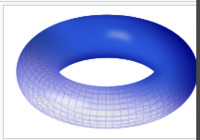The equation describing the circle to be rotated is:
[MATH](x-b)^2+y^2=a^2[/MATH]
Now, so that we know what our goal is, using the formula for the volume of a torus, we should expect to find the volume of the solid of revolution to be:
[MATH]V=2\pi^2a^2b[/MATH]
Let's use both the washer and shell methods. We'll begin with the washer method.
Washer Method
The volume of an arbitrary washer is:
[MATH]dV=\pi\left(R^2-r^2 \right)\,dy[/MATH]
where:
[MATH]R=b+\sqrt{a^2-y^2}[/MATH]
[MATH]r=b-\sqrt{a^2-y^2}[/MATH]
Hence:
[MATH]R^2-r^2=(R+r)(R-r)=(2b)\left(2\sqrt{a^2-y^2} \right)=4b\sqrt{a^2-y^2}[/MATH]
And so the volume of the arbitrary washer can be written as:
[MATH]dV=4\pi b\sqrt{a^2-y^2}\,dy[/MATH]
Now, summing the washers, we get the volume of the solid:
[MATH]V=4\pi b\int_{-a}^a \sqrt{a^2-y^2}\,dy[/MATH]
Using the even-function rule, this becomes:
[MATH]V=8\pi b\int_0^a \sqrt{a^2-y^2}\,dy[/MATH]
Using the substitution:
[MATH]y=a\sin(\theta)\,\therefore\,dy=a\cos(\theta)\,d \theta[/MATH]
We have:
[MATH]V=8\pi b\int_{\theta(0)}^{\theta(a)}\sqrt{a^2-a^2\sin^2(\theta)}\,a\cos(\theta)\,d\theta[/MATH]
Now, to change the limits of integration, observe we have:
[MATH]\theta(x)=\sin^{-1}\left(\frac{y}{a} \right)[/MATH] and so:
[MATH]\theta(0)=\sin^{-1}\left(\frac{0}{a} \right)=0[/MATH]
[MATH]\theta(a)=\sin^{-1}\left(\frac{a}{a} \right)=\frac{\pi}{2}[/MATH]
Now, on the interval [MATH]\left(0,\frac{\pi}{2} \right)[/MATH], we have the sine and cosine functions being non-negative, hence we may write the integral as:
[MATH]V=8\pi b\int_{0}^{\frac{\pi}{2}}a\sqrt{1-\sin^2(\theta)}\,a\cos(\theta)\,d\theta[/MATH]
[MATH]V=8\pi a^2b\int_{0}^{\frac{\pi}{2}}cos^2(\theta)\,d\theta[/MATH]
Now, using the identity [MATH]\cos^2(x)=\frac{1+\cos(2x)}{2}[/MATH] we have:
[MATH]V=4\pi a^2b\int_{0}^{\frac{\pi}{2}}1+\cos(2\theta)\,d \theta[/MATH]
Hence:
[MATH]V=4\pi a^2b\left[\theta+\frac{1}{2}\sin(2\theta) \right]_{0}^{\frac{\pi}{2}}=4\pi a^2b\left(\frac{\pi}{2} \right)=2\pi^2a^2b[/MATH]
Okay, this is the result we expected. Now let's look at the shell method.
Shell Method
The volume of an arbitrary shell is:
[MATH]dV=2\pi rh\,dx[/MATH]
where:
[MATH]r=x[/MATH]
[MATH]h=2\sqrt{a^2-(x-b)^2}[/MATH]
And thus the volume of the arbitrary shell is:
[MATH]dV=4\pi x\sqrt{a^2-(x-b)^2}\,dx[/MATH]
Summing up the shells, we get the volume of the solid:
[MATH]V=4\pi\int_{b-a}^{b+a} x\sqrt{a^2-(x-b)^2}\,dx[/MATH]
Using the substitution:
[MATH]x-b=a\sin(\theta)\,\therefore\,dx=a\cos(\theta)\, d\theta[/MATH]
we obtain:
[MATH]V=4\pi\int_{-\frac{\pi}{2}}^{\frac{\pi}{2}} \left(a\sin(\theta)+b \right)\sqrt{a^2-a^2\sin^2(\theta)}\,a\cos(\theta)\,d\theta[/MATH]
[MATH]V=4\pi a^2\int_{-\frac{\pi}{2}}^{\frac{\pi}{2}} \left(a\sin(\theta)+b \right)\sqrt{1-\sin^2(\theta)}\,\cos(\theta)\,d\theta[/MATH]
[MATH]V=4\pi a^2\int_{-\frac{\pi}{2}}^{\frac{\pi}{2}} \left(a\sin(\theta)+b \right)\cos^2(\theta)\,d\theta[/MATH]
[MATH]V=4\pi a^3\int_{-\frac{\pi}{2}}^{\frac{\pi}{2}} \sin(\theta)\cos^2(\theta)\,dx+4\pi a^2b\int_{-\frac{\pi}{2}}^{\frac{\pi}{2}}\cos^2(\theta)\, d\theta[/MATH]
Using the odd and even function rules, we obtain:
[MATH]V=8\pi a^2b\int_{0}^{\frac{\pi}{2}}\cos^2(\theta)\, d\theta[/MATH]
Now, using the identity [MATH]\cos^2(x)=\frac{1+\cos(2x)}{2}[/MATH] we have:
[MATH]V=4\pi a^2b\int_{0}^{\frac{\pi}{2}}1+\cos(2\theta)\,d \theta[/MATH]
Hence:
[MATH]V=4\pi a^2b\left[\theta+\frac{1}{2}\sin(2\theta) \right]_{0}^{\frac{\pi}{2}}=4\pi a^2b\left(\frac{\pi}{2} \right)=2\pi^2a^2b[/MATH]
Here we have also obtained the desired result.

 according to me the diagram may look like but not very sure
according to me the diagram may look like but not very sure
 according to me the diagram may look like but not very sure
according to me the diagram may look like but not very sure
